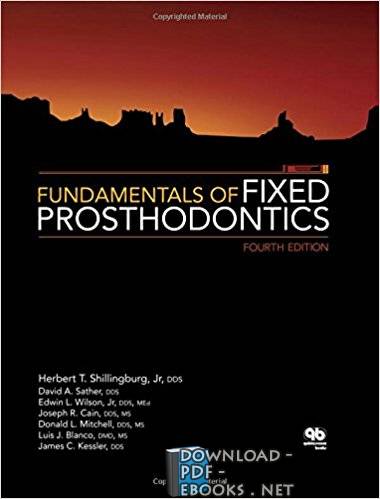

❞ كتاب Fundamentals of Fixed Prosthodontics Fourth Edition ❝
Fixed prosthodontics is the art and science of restoring damaged teeth with cast metal, metalceramic,
or all-ceramic restorations and of replacing missing teeth with fixed prostheses using metalceramic
artificial teeth (pontics) or metal-ceramic crowns over implants. Successfully treating a
patient by means of fixed prosthodontics requires a thoughtful combination of many aspects of dental
treatment: patient education and the prevention of further dental disease, sound diagnosis, periodontal
therapy, operative skills, occlusal considerations, and, sometimes, placement of removable complete
or partial prostheses and endodontic treatment.
Restorations in this field of dentistry can be the finest service rendered for dental patients or the
worst disservice perpetrated upon them. The path taken depends upon one’s knowledge of sound
biologic and mechanical principles, the growth of manipulative skills to implement the treatment plan,
and the development of a critical eye and judgement for assessing detail.
As in all fields of the healing arts, there has been tremendous change in this area of dentistry in
recent years. Improved materials, instruments, and techniques have made it possible for today’s
operator with average skills to provide a service whose quality is on a par with that provided only by
the most gifted dentist of years gone by. This is possible, however, only if the dentist has a thorough
background in the principles of restorative dentistry and an intimate knowledge of the techniques
required.
This book was designed to serve as an introduction to the area of restorative dentistry dealing with
fixed partial dentures and cast metal, metal-ceramic, and all-ceramic restorations. It should provide
the background knowledge needed by the novice as well as serve as a refresher for the practitioner or
graduate student.
To provide the needed background for formulating rational judgments in the clinical environment,
there are chapters dealing with the fundamentals of treatment planning, occlusion, and tooth
preparation. In addition, sections of other chapters are devoted to the fundamentals of the respective
subjects. Specific techniques and instruments are discussed because dentists and dental technicians
must deal with them in their daily work.
Alternative techniques are given when there are multiple techniques widely used in the profession.
Frequently, however, only one technique is presented. Cognizance is given to the fact that there is
usually more than one acceptable way of accomplishing a particular task. However, in the limited
time available in the undergraduate dental curriculum, there is usually time for the mastery of only one
basic technique for accomplishing each of the various types of treatment.
An attempt has been made to provide a sound working background in the various facets of fixed
prosthodontic therapy. Current information has been added to cover the increased use of new
cements, new packaging and dispensing equipment for the use of impression materials, and changes in
the management of soft tissues for impression making. New articulators, facebows, and concepts of
occlusion needed attention, along with precise ways of making removable dies. The usage of
periodontally weakened teeth requires different designs for preparations of teeth with exposed root
morphology or molars that have lost a root.
Different ways of handling edentulous ridges with defects have given the dentist better control of
-
من كتب طب الأسنان - مكتبة كتب الطب.



 قبل تحميل الكتاب ..
قبل تحميل الكتاب .. 

 منصّة المكتبة
منصّة المكتبة